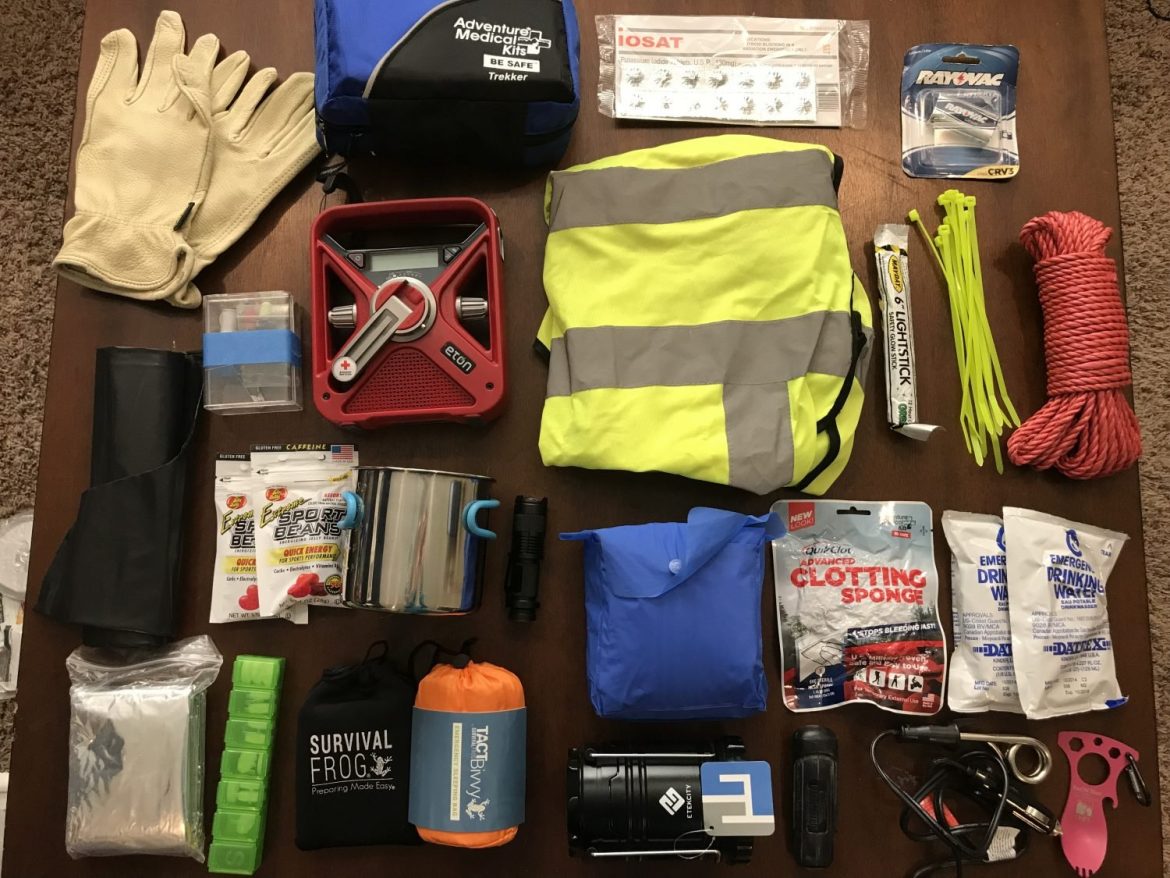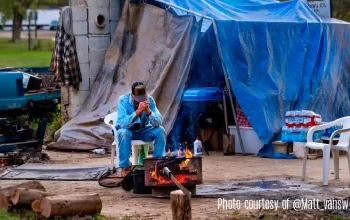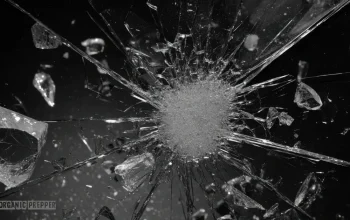As a parent or guardian, ensuring the safety of your children, especially as they transition to college, is a top priority. This guide helps you create a versatile college emergency kit tailored for your student(s), with principles applicable to your entire family. By investing time in preparedness now, you’ll gain peace of mind knowing your child is better equipped to handle unexpected challenges while on campus.

Some of the links in this post may contain affiliate links for your convenience. As an Amazon Associate, I may earn a small commission from qualifying purchases without any increase in price to you.
The Planning Process
My daughter packed for college very thoughtfully and methodically. She sorted through her favorite books and mementos, then she went through her clothes, sorted them, and made decisions about what to take with her to her new hometown. During the winter, it’s colder than where we live, so she packed jackets, heavy socks, and all the winter-weather clothing she owned. A college emergency kit wasn’t exactly on her list of priorities.
As she did her packing, I was doing some mom-thinking. My sweet little firstborn was moving a good 3 hours from home. I wanted her to be equipped for emergencies that extended beyond chilly winter weather. I began putting together emergency supplies that will spend most of their time in her SUV. She parks very close to her dorm, so the gear and supplies will always be handy.
I wanted to share with you my thought process as I put this college emergency kit together because it doesn’t apply to just college students. It uses the same key principles for building any emergency kit. Your own emergency kits and supplies will be outfitted in much the same way, so pay attention!
The College Emergency Kit: An Overview
To effectively organize and utilize the available space in her vehicle, a strategic approach was crucial. This section breaks down the components of the emergency kit and explains their purpose.
Vehicle Preparation
First, a look at my daughter’s stocked vehicle:

Since she has plenty of room in the SUV, I felt comfortable packing all of this. Typically, when we think of survival and being prepared, we emphasize packing multi-purpose supplies and gear and packing light. In this case, I’d rather she have more than she needs, especially since she will likely be alone in her travels.
Backpack
Her backpack is an important part of the plan because it’s important to have something that is easy and comfortable to carry in case she ever has to leave her vehicle behind and walk to safety on foot. In that type of emergency, she could check out the contents of the bag, remove anything that isn’t vital, and replace with other items from the bucket, add the MREs, the water filter, and so on. The backpack already holds many of the fundamental survival supplies, such as a multi-tool and a fixed-blade knife. With the addition of our family emergency communication plan so we know how to contact each other in emergencies, she is well-prepared.
MRE Meals
I only packed a couple of MRE meals for her, in this case. There are other snacks in her backpack and in the bucket, so I didn’t pack too much in the way of food. You can read all about MRE meals here, and check out the different varieties on this Amazon page.
Generally, MREs are compact, high in calories, but are not lightweight for carrying in a backpack. Along with other snacks and high-calorie energy bars, she’ll have enough food for up to 48 hours. I might add another 3 or 4 meals when she comes home for Thanksgiving.

The Emergency Bucket
For this, I reused a bucket left over from Mountain House emergency meals kit, but a 5-gallon bucket would do just as well. I like having a heavy-duty plastic bucket with my emergency gear because it can be used as an emergency toilet and used to carry firewood and water.

Starting at the top row:
- Heavy-duty pair of work gloves, something she’ll need if she ever has to change a tire or any other manual task. You don’t want to worry about splinters or scuffed-up knuckles when you’re dealing with an emergency.
- A small, all-purpose first aid kit. It holds most of the basics and I’ve added ibuprofen and Benadryl. You’ll want to add anything specific to your family’s medical and health needs.
- IOSAT potassium iodide tablets for a possible nuclear event. This isn’t something I highly anticipate, but she’s a young woman whose thyroid would be damaged by radiation.
- Extra AA batteries for flashlights, the emergency radio, and anything else battery-powered. I’m going to add a set of these USB-charged batteries so she won’t have to worry about continually replacing them.
- Small sewing kit that I made myself. It contains several needles of different sizes, stick pins, and threads in different colors.
- Emergency crank radio that is powered by a small solar charger, batteries and a hand crank. She will probably have the use of her car radio, but this one is small enough to pack in her backpack and keep in her dorm, which happens to be in tornado country. It also has a pre-set NOAA radio band, so she’ll always be up to date with weather reports.
- Yellow reflective vest could save her life if she ever has to be out and about on the roadside at night, especially. These are inexpensive, right around $6 and a very easy prep for your vehicle emergency kit.
- Lightstick — I only packed one of these because it was all I had! However, she has a small lantern and an LED flashlight, which are superior as sources of light. A lightstick is handy for signaling at night, though, and worth having a dozen or so on hand.
- Zip ties are a poor man’s carabiner. They can attach anything to anything and in an emergency can be worth their weight in gold. Plus, they take up very little room in a backpack or kit.
- Rope — This bundle of rope is all-purpose. With a large blanket or tarp, she could set up a shelter from the sun or rain, and a rope is one of those all-purpose pieces of gear that doesn’t have any good substitutes.
- Black trash bags in a roll — I think I packed 4 or 5 of them for her. They are the heavy-duty contractor bags and can double as a rain shelter, protect gear from wet weather, use as a ground cover, and so many other uses. Since they’re inexpensive, that’s another bonus.
- Sports Beans for energy, caffeine, electrolytes, and nutrients, similar to chewing on a multivitamin, only better tasting! I highly recommend stocking up on these and then putting a few bags in each emergency kit.
- Stainless steel camping mug/small cooking pot for warming water or MRE meals.
- Small LED flashlight but be aware, not all are the same. You want one with a powerful beam of light. In the dark, you’ll be grateful to have that amount of light in such a small package. Along with the flashlight, you might want to add a headlamp for hands-free lighting.
- Rain poncho for rainy days and nights, but so much more as it can also protect from the sun. If she had to, she could use the poncho as another layer of clothing on a really cold night.
- Advanced Clotting Sponge is the one addition to the basic emergency kit to be used in case of severe bleeding. My daughter has taken a first aid class and knows the basics, but when it comes to major bleeding, the kind that soaks through bandages, pads, cloth, anything, and everything, she’ll need to use this hemostatic dressing.
- Mylar pouches of water are handy when you want to carry a smaller amount of water (if you live near bountiful natural water sources) and want to make sure the container is heavy duty. The mylar used for these pouches is extremely strong and so far, we have never had one leak.
- Emergency blanket, this is not my favorite emergency supply because it is actually made from very flimsy mylar, but in a pinch, it could be used to collect rainwater, for signaling, as a drop cloth to keep supplies dry, etc. Since she has a good sleeping bag for warmth, the inclusion of this is more for its versatility than use as a blanket.
- 7-Day Pill Organizer for extra medication/supplements. These are about $2 at a drug store. It’s also a handy way to store very small things, like safety pins.
- Mini cook-stove — You can’t see it in the black pouch, but it’s there! It’s similar to this one and comes with a supply of fuel blocks like these. Although I included an immersion heater in the bucket, if her car battery is ever out of juice, it will be nice to have another way to heat up food and water and have a small, safe heat source.
- Tact Bivvy for all-purpose shelter and protection from the elements. It’s pretty obvious I believe in redundancy, and the Tact Bivvy is not quite a sleeping bag but for my daughter, who is cold even on hot Texas summer days, I thought it would be a huge advantage for her to use as another layer against the cold combined with her sleeping bag. When we were camping in Iceland we used cozy fleece bags inside our heavy duty sleeping bags and most nights slept very comfortably. I added the Tact Bivvy to be used in the same way.
- Etekcity collapsible LED lantern for ambient light. While the LED flashlight will provide directional lighting, you also need something to light up a large area and that’s where ambient lighting comes in. This handy lantern is small but produces a lot of light. The lantern runs on AA batteries, perfect for this rechargeable USB set. In some ways, I like the Luci lantern better because it collapses flat and is solar charged. You can read all about the Luci here.
- BlastMatch for starting fires. Every kit should have 1 or 2 different ways to safely start a fire and the BlastMatch is super easy to use.
- Immersion warmer for heating food using the car battery. In an emergency, a warm meal can do wonders for restoring energy and morale. My daughter is a coffee lover, so some hot water mixed with a packet of instant coffee would do her a world of good. Check out my article about packing a winter survival kit for more suggestions for emergency meals and drinks.
- Eat ‘N Tool for all the eating she’ll be doing! This handy all-in-one spoon, fork, carabiner, screwdriver, pry opener — it makes an awesome stocking stuffer, which is how she got it in the first place!
- Not shown in photo: reusable nylon grocery bag, insect repelling wristband, SABRE Pepper Spray, and my new favorite product, an Epic Wipe for an emergency bath.
Additional Supplies
Here are close-ups of everything else that girl has in her vehicle, including the wonderful Light my Fire Swedish Fire Knife. Everyone in my family has one of these knives. They’re excellent.
Water Supply

Firestarter

Clothing
Along with gear and supplies, my daughter knows the importance of starting with clothing for survival. She has waterproof hiking boots, wool socks, long underwear, and a water/wind repellent jacket. When you start out with the right clothing and footwear, it’s amazing how ready you are to survive, even without a lot of extra fluff.
Tips for Creating Your Student’s Kit
- Tailor the kit to your child’s specific needs, allergies, and medical conditions.
- Include a small amount of cash for emergencies only, not late-night Taco Bell runs.
- For situations where traditional power sources are unavailable, a solar-powered power bank can be a lifesaver.
Frequently Asked Questions
Most colleges have detailed emergency response plans. Review your student’s college’s plan together and familiarize yourself with evacuation procedures, contact information, and emergency notifications. This knowledge can be invaluable in a crisis.
Encourage your child to sign up for all college emergency notification systems. These systems typically use text messages, emails, or dedicated apps to provide timely updates during crises.
Develop a specific communication plan with your child, including designated phone numbers and a backup contact person. Text messages are often more reliable than calls during emergencies.
Related College Student Content

Final Thoughts
So, my daughter is launched and enjoying herself at college. And I have the peace of mind that with her college survival kit, she is well-equipped to handle most any emergency that comes her way.
What else would you include?






